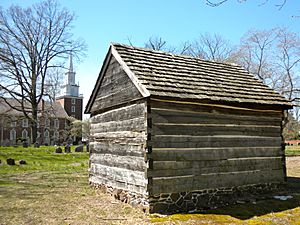New Sweden Farmstead Museum facts for kids
| Established | 1988 |
|---|---|
| Dissolved | circa 2015 |
The New Sweden Farmstead Museum was a special outdoor museum in Bridgeton, New Jersey, USA. It was like stepping back in time to a 17th-century Swedish farm. The museum showed what life was like for the Swedish and Finnish people who came to America long ago to start the New Sweden colony.
It first opened in 1988 and was a "living museum" for many years. This means people dressed up and showed how things were done back then! But over time, it became harder to get money and visitors. The old log buildings started to fall apart, so the museum had to close.
Later, people worked hard to raise money and fix the buildings. In 2015, a plan was made to move the museum's buildings to a new home. They were moved to Governor Printz Park in Essington, Pennsylvania. On June 1, 2019, the main house was ready and celebrated. The other six buildings were rebuilt in 2020. The whole farmstead was officially opened to visitors on June 12, 2021, with a special dedication ceremony on June 12, 2022.
Contents
Exploring New Sweden's History
In 1638, people from Sweden and Finland sailed to the Delaware Valley on two ships, the Kalmar Nyckel and Fogel Grip. They came to start a new colony called New Sweden. Many Finns settled first around Finns Point.
In 1643, they built Fort Nya Elfsborg near Salem, New Jersey. These settlers spread across South Jersey into areas like Salem, Cumberland, and Gloucester. They built farming towns along the rivers and streams. One early settler, Eric Pålsson Mullica, is remembered in many local place names. By 1649, villages like Sveaborg (now Swedesboro, New Jersey) and Nya Stockholm (today's Bridgeport) were created. It's thought that these early Finnish settlers helped bring the idea of log building to the USA.
Some original buildings from this time are still standing today. They are among the oldest buildings in New Jersey and some of the oldest non-Spanish buildings in the United States. These include the Caesar Hoskins Log Cabin and the C. A. Nothnagle Log House. The Mortonson-Van Leer Log Cabin was moved to Old Swedes Church in Swedesboro. There are also the Swedish Granary and the Swedish Cabin at Hancock House.
Building the Museum Farmstead
The New Sweden Company was started in 1983. Their goal was to build a village to celebrate 350 years since the first European colonists arrived. The project was first planned for Salem, New Jersey, but after some discussion, it was built in Bridgeton instead.
The museum was built in 1987. Experts from Sweden helped supervise the construction. They used old-fashioned materials and methods to build the log structures. This made the farmstead, or gård, look just like one from the 17th century. It included a farmhouse, a blacksmith shop, a storehouse, a Granary (for drying grain), a stable, a barn with an outhouse, a sauna, and a Smokehouse. Even the fireplaces and chimneys were built in the old style. The museum also had real Swedish-Finnish furniture, farm tools, and other items.
The museum officially opened on April 14, 1988. King Carl XVI Gustaf and Queen Silvia of Sweden attended, along with Governor of New Jersey Thomas Kean. The royal family even gave candleholders to the museum.
Why the Museum Moved
The farmstead was a popular place for about 10 years. But then, the local economy faced problems. Less money was available, and fewer people visited. Because of this, the museum eventually closed.
By 2011, a group called the New Sweden Colonial Homestead Foundation began raising money to fix and reopen the museum. The weather had damaged the buildings. It was estimated that about $10,000 was needed for roof repairs on each building.
In September 2011, the Swedish Ambassador to the United States, Jonas Hafström, attended a fundraising event. This helped bring attention to the foundation's efforts. The homestead received grants from Cumberland County and the Swedish Council of America. In 2012, a local company donated $10,000. The Swedish Colonial Society also helped with the restoration. Eventually, plans were made to permanently close the Bridgeton location and move the museum.
A New Home for the Farmstead
In 2015, people thought about moving the museum to Wilmington, Delaware. This was where New Sweden's Fort Christina was located. Later, the decision was made to move the buildings to Governor Printz Park in Essington, Pennsylvania. This park is the site of New Sweden's The Printzhof.
On June 1, 2019, the main residence building was rebuilt and celebrated in the park. In 2020, the other six buildings were reconstructed. This happened while the park was closed due to the COVID-19 pandemic. The completed farmstead had its first open house on June 12, 2021. A special dedication ceremony was held the following year, on June 12, 2022.
See also
- Hewing
- Log home
- Forest Finns
- Eskilstuna, Swedish sister city of Bridgeton
- Morton Homestead


